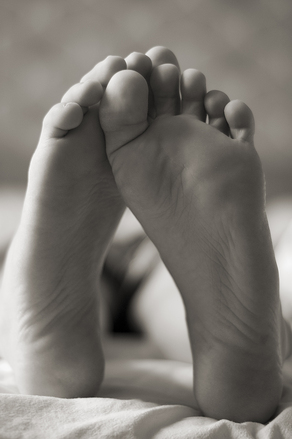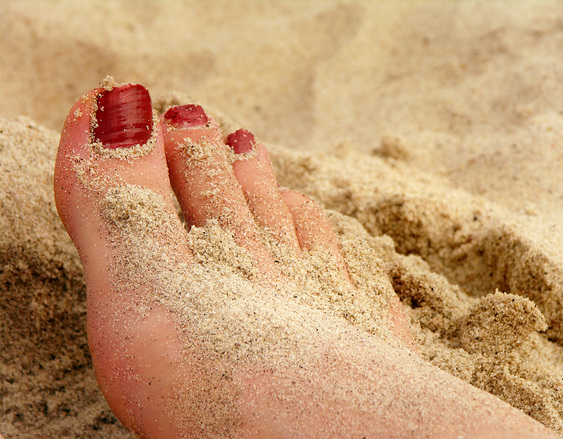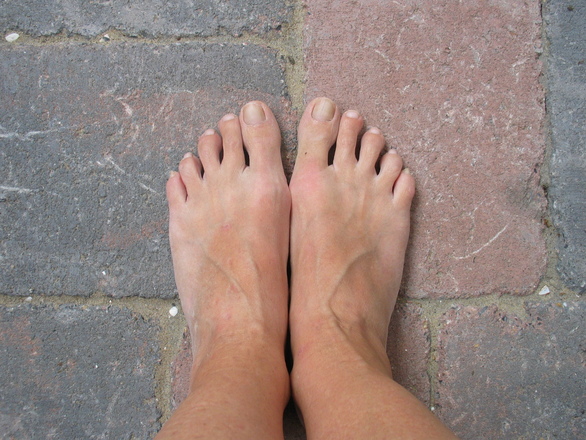Many people don’t visit a podiatrist unless they have a foot problem, but there are several conditions and health signs that have to do with your feet that could also mean a lot more about your overall health. Just one exam of the feet, can clue you in to various health concerns and potential problems, that may have been otherwise overlooked.
Nationally renowned Podiatrist and Vionic Innovation Lab Member, Dr. Jackie Sutera, is here to address common “Red Flag” foot clues and conditions and what it could mean about your overall health as well as provide advice on what to do and how to go about treating them.
1)Brittle Toenails
What could be wrong: Vitamin deficiency
Brittle toenails can signify a lack of vitamin A and D since vitamin D, along with calcium and magnesium, are the foundation for healthy nails. Lack of essential fatty acids can also cause inflammatory conditions around the nails, which in turn render nails weak and brittle. Some medical conditions responsible for causing nails to become weak and brittle also include Raynaud’s disease, hypothyroidism, lung conditions, tuberculosis, and Sjogren’s syndrome.
2) Disappearing Hair on Toes
What could be wrong: Poor circulation
Hair follicles don’t have enough circulation to remain intact so they slough off. Often it’s accompanied by a cool foot temperature. Poor circulation can also be heart related; a weak heart-pumping mechanism can cause circulatory issues. Other reasons circulation is compromised are: obesity, varicose veins, edema, peripheral vascular disease, and diabetes.
What to do: For people with edema- compression stockings and elevatation are helpful. Walking is essential! The large muscles in the legs act as pumps which keeps blood moving. Patients should be evaluated by a podiatrist who can refer to a vascular surgeon when necessary.
3) Numbness
What could be wrong: Diabetes
Podiatrists perform various types of nerve testing to check a patient’s vibratory, reflexes, sharp and dull sensations. People with decreased sensation have a peripheral neuropathy, which may signal diabetes because high sugar impacts the nerves so they don’t function well. If you have neuropathy but good blood sugar checks levels, you may have a misaligned position of the foot where when weight is placed on the foot, it collapses. A nerve that runs along the side of the foot becomes stretched and eventually compressed and leads to losing nerve sensation there.
What to do: Custom orthotics, little inserts in shoes, helps correct the alignment.
4) Burning Feet
What could be wrong: Neuropathy (numbness)
Neuropathy is a general term meaning nerve dysfunction. Causes include diabetes, vitamin deficiency, and side effects from medications. The first step is to determine the cause of the neuropathy. If no cause can be identified, this is called idiopathic peripheral neuropathy. Medications can be prescribed to decrease neuropathic pain and burning sensation. Daily self examinations of feet is key to keeping feet healthy. If there are breaks in the skin or anything usual and sensation is compromised one may not even realize there is a potential problem!
5) Toes that Tip Up
What could be wrong: Lung, heart or gastrointestinal issues
It can be one toe or multiple and is usually a red flag for a pulmonary or lung disease, even lung cancer. It can also be a gastro issue, like Crohn’s disease or heart disease.
What to do: A podiatrist can xray and evaluate the foot bones initially then a follow up with the patient’s primary care doctor needs to hone in on what’s going on with additional testing.
6) Shooting Pain in Your Heel
What it means: Plantar fasciitis — inflammation of a band of connective tissue (fascia) running along the bottom (plantar) of the foot — is abnormal straining of the tissue beyond its normal extension.
More clues: The pain starts when you take your first steps in the morning and often intensifies as the day wears on. It’s usually concentrated in the heel (one or both) but can also be felt in the arch or in the bottom of the foot. Running and jumping a lot can cause it, but so can insufficient support. You’re at risk if you go barefoot a lot or wear old shoes or flimsy flip-flops, have gained weight, or walk a lot on hard surfaces.
What to do: Rest, massage the arch, stretch the calf and ice! If pain persists more than a few weeks or seems to worsen, have it evaluated by a podiatrist. Stick to low shoes with a strong supportive arch until you get further advice and treatment (which may include anti-inflammatory drugs and shoe inserts). Invest in supportive footwear, like shoes from Vionic, that you can wear to save your feet and heal and prevent a plantar fasciitis and a variety of other pains.
7) A Sore that Won’t Hel at the Bottom of Your Foot
What it means: This is a major clue to diabetes. Elevated blood glucose levels lead to nerve damage in the feet — which means that minor scrapes, cuts, or irritations caused by pressure or friction often go unnoticed, especially by someone who’s unaware he has the disease. Untreated, these ulcers can lead to very serious infections, even amputation. More clues: Oozing, foul-smelling cuts are especially suspect because they’ve probably been there awhile. Other symptoms of diabetes include persistent thirst, frequent urination, increased fatigue, blurry vision, extreme hunger, and weight loss.
What to do: Get the ulcer treated immediately and see a doctor for a diabetes evaluation. Diabetics need to inspect their feet daily (older people or the obese should have someone do this for them) or use a handheld mirror. They should see a podiatrist every three months.
8) Painful, Red, Swollen Big Toe Joint
What could be wrong: Gout
Gout develops when there is a high amount of uric acid, usually from diet, whether it’s from drinking a lot of wine, or from chocolate, cheeses, or red meat. Patients with gout are either overproducing or under-excreting uric acid.
What to do: See your podiatrist who may inject the toe joint with cortisone to get the acute swelling down. Cortisone acts as an anti inflammatory. Patients are encouraged to use warm compress on the area, wear comfortable shoes, and to discontinue eating the rich gout triggering foods. Patients then eat a low-purine diet and take preventative medication. Drinking plenty of water and staying hydrated is also key to flush out the uric acid.
9) Cramps or Charley Horse
What could be wrong: Dehydration, low potassium
Foot cramps and charley horses in the calf are usually a result of low potassium or dehydration.
What to do: If you have an issue with cramping of feet or legs, eat a banana before vigorous exercise and drink plenty of water before and after. Try stretching and icing feet before sleeping.
10) Pitted Toenails
What could be wrong: Psoriasis
In about half of all people with psoriasis, finger and toenails have tiny little holes like pits. More than three-fourths of those with psoriatic arthritis, a type of arthritis related to psoriasis that affects joints, also have pock-marked nails. Nails may also be thick, yellow or brownish. Your doctor can diagnose and treat psoriasis and psoriatic arthritis with medication, diet and lifestyle changes. Nails can sometimes be restored to normal if treatment is sought early.
11) Twisting And Bulging Of Veins
What could be wrong: Spide/Varicose Veins
Twisted, enlarged veins indicate that you have varicose veins. Generally, the veins in your legs and hands are affected. Standing and walking upright over time increases the pressure in the veins of the affected area. Many individuals consider varicose veins and spider veins an cosmetic anomaly. If left untreated, varicose veins can cause aching pain and discomfort in the long run and the severity of the issue can also increase. It is possible to treat varicose vein/spider vein through proper consultation and treatment. Vein Center is one such medical institution that specializes in the treatment of varicose and spider veins.
Author’s Bio:
This guest post was provided by nationally renowned podiatrist, Dr. Jackie Sutera.


